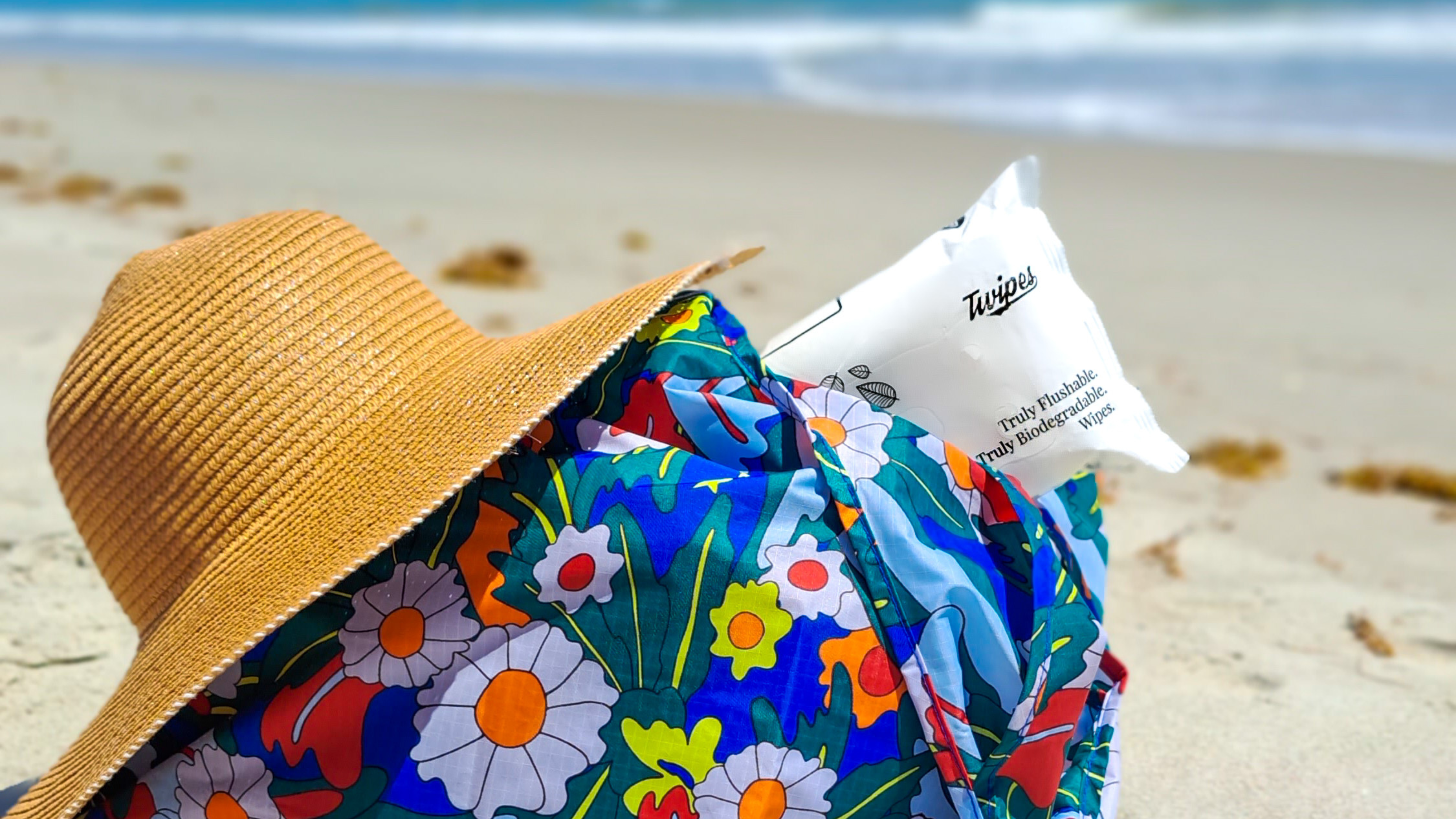Summer’s here, and that means it’s time to pack up your sunscreen, grab your flip-flops, and head to the beach. But before you kick back and soak up the sun, let’s talk about how you can keep your beach trip as eco-friendly as possible. Because nothing ruins a day by the ocean like realizing that your fun in the sun is contributing to the Great Pacific Garbage Patch.
No worries, though! We’ve got your back with this handy guide to a sustainable beach day. From what to pack (hint: it involves Twipes) to how to clean up after yourself, here’s everything you need to know to enjoy a guilt-free day at the shore.
1. Choose an Eco-Conscious Beach
When planning your trip, consider beaches that hold a Blue Flag certification. This certification indicates the beach meets stringent environmental educational safety and accessibility criteria. By choosing a Blue Flag beach, you’re supporting locations that prioritize protection and sustainable tourism.
2. Pack Responsibly
What you bring to the beach plays a significant role in how sustainable your day will be. Opt for durable, reusable items rather than single-use products. Here’s a sustainable packing list:
- Reusable Water Bottles: Instead of purchasing plastic water bottles, bring a reusable one. It keeps you hydrated without contributing to plastic waste.
- Reef-Safe Sunscreen: Many sunscreens contain chemicals harmful to marine life, especially coral reefs. Choose a sunscreen labeled as reef safe, free from ingredients like oxybenzone and octinoxate.
- Reusable Bags and Containers: Ditch plastic bags in favor of reusable totes and containers. These reduce waste and often last much longer, making them a more cost-effective choice in the long run.
- Twipes: After a day at the beach, Twipes are a convenient, eco-friendly option for cleaning up. Biodegradable and plastic free, Twipes allow you to stay clean without contributing to the problem of microplastics in the environment.
3. Practice the Leave No Trace Principle
The Leave No Trace principle is simple but powerful: whatever you bring to the beach, take it back with you. This includes even the smallest pieces of litter, like food wrappers of bottle caps, which can be harmful to wildlife. Carry a reusable bag specifically for trash and recyclables, ensuring that nothing is left behind.
While picking up your trash is crucial, consider going a step further. If you spot litter left by others, picking it up and disposing of it properly can significantly impact the overall cleanliness of the beach.
4. Avoid Single-Use Plastic
Single-use plastics are one of the largest contributors to ocean pollution. To minimize your impact, avoid bringing disposable items such as plastic cutlery, straws, and plates. Instead, pack reusable alternatives. For example, bring metal or bamboo cutlery, a reusable straw, and washable plates or containers. These items are easy to clean and reuse, and they reduce the amount of plastic waste that could end up in the ocean.
5. Respect Wildlife and Habitats
Beaches are not only a playground for humans, but also vital habitats for wildlife. Respect the natural environment by not disturbing the local flora and fauna. Avoid feeding seagulls or other birds, as this can disrupt their natural feeding behaviors and contribute to pollution. Additionally, stay clear of any marked nesting areas or dunes, which are often critical habitats for species like sea turtles and shorebirds.
6. Conserve Water
While at the beach, be mindful of water usage. If the beach has public showers, use them sparingly—just enough to rinse off sand. Freshwater is a precious resource, even in coastal areas, and conserving it helps reduce the strain on local water supplies.
7. Support Local, Sustainable Businesses
After a day at the beach, choose to dine at local restaurants that prioritize sustainability. Many coastal towns offer seafood sourced from sustainable fisheries, as well as locally grown produce. Supporting these businesses help promote sustainable practices and reduces the environmental footprint of your meal. Look for restaurants that emphasize eco-friendly practices, such as using biodegradable packaging and minimizing food waste.
8. Educate and Advocate
An essential part of being an eco-conscious beachgoer is spreading awareness. Share your knowledge about sustainable practices with friends and family. Encourage them to adopt eco-friendly habits, and lead by example during group outings. Additionally, consider participating in or organizing beach clean-up events to engage with the community and raise awareness about the importance of protecting out coastal environments. An essential part of being an eco-conscious beachgoer is spreading awareness. Share your knowledge about sustainable practices with friends and family. Encourage them to adopt eco-friendly habits, and lead by example during group outings. Additionally, consider participating in or organizing beach clean-up events to engage with the community and raise awareness about the importance of protecting out coastal environments
Wrapping it Up (Without the Plastic)
Enjoying a day at the beach can be both relaxing and responsible. By choosing a sustainable approach, you contribute to the preservation of our natural environments. From packing reusable items and Twipes, to supporting local businesses and respecting wildlife, every small action adds up. Together, we can ensure that our beaches remain beautiful and healthy for future generations to enjoy.
To see how you can use Twipes in other locations around Buffalo, make sure to read How to Use Twipes: 716 Edition
To learn more about how you can incorporate eco-friendly practices in your everyday life, visit twipes.com.



